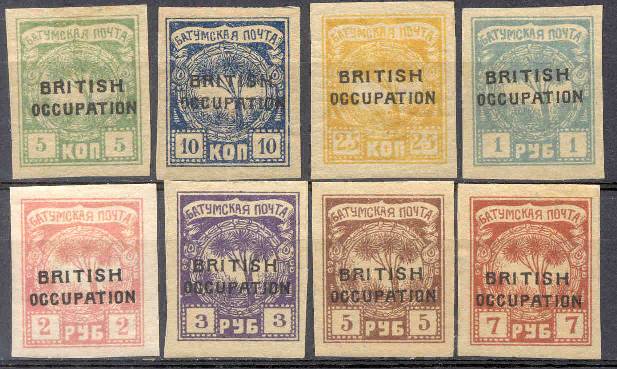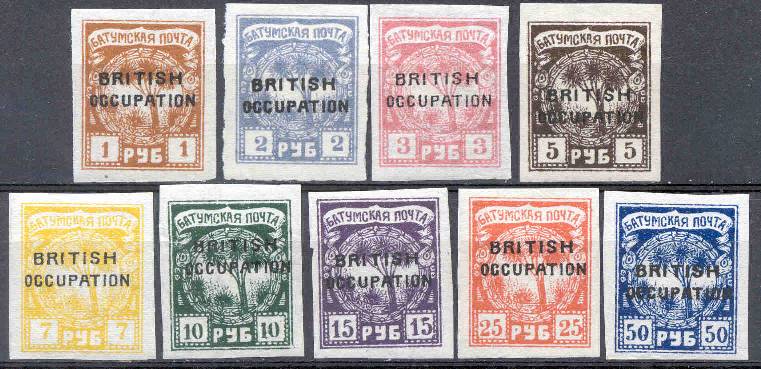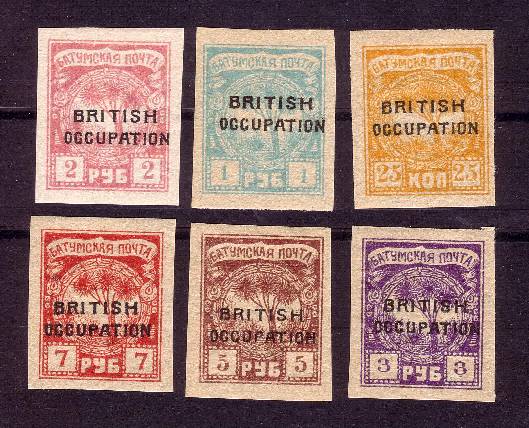

BATUM AND ITS STAMPS Batumi is a Black Sea oil port
at the end of an oil line from Baku (situated at the other end of the Caucasus). In 1878
its turbulent modern history began when it was taken by Russia from Turkey. Joseph Stalin
arrived there in 1901 to organise strikes and was twice imprisoned in the next two years.
Following the fall of the Tsar, the Caucasian peoples reasserted their independence and
Turkey saw its chance to win back old territory. Its troops entered Batum in April 1918.
From this time date letters handstamped Batumskaya Kontora during a shortage of
stamps at the Post Office and thus begins Batum s philatelic history. The British arranged to take over the whole of the Caucasian oil
producing area later that year and their troops began entering Batum from Christmas 1918.
The stamp situation was even worse by then and the territory produced its very own stamps
in February 1919. These were the six roughly lithographed imperforates depicting an aloe
tree and inscribed Batumskaya Pochta. The eight stamp set issued later that year and
overprinted BRITISH OCCUPATION is generally better known. Many other overprints in both
English and Russian followed on Russian stamps until July 1920, when the British moved
out again. By 1921 Batum was part of the Georgian SSR, when the province of Adzhar of
which it is capital was declared an autonomous republic. The province, now called Ajaria, has retained its semi-independent
status down to the present day. In 1991 it was linked to the newly independent Georgian
republic and Russian troops were stationed in Batum. From 1993 it began bringing out
themed sets of stamps aimed at the philatelic market. These are generally regarded as
fantasies (or more politely privately issued ). Rather than the name of the autonomous
republic, they bear the name Batum in Latin characters, Batumi in Russian and what looks
like Batumgh in Georgian writing. No doubt this is an appeal to the precedent of the 1919
issue. On March 29, 1999, the Georgian Ministry of Posts and Communications
sent notice to the Postal Union declaring that stamps issued in the names of the so
called republics of Abkhazia and South Ossetia , and in addition Batumi, were spurious.
This is disingenuous, to say the least. The first two areas have been at war with Georgia
since 1991 and, what s more, have more or less fought the Georgian army to a standstill.
Georgia may not like it, but the areas in question have de facto independence and so a
perfect right to run their own postal systems. As for Batum, later that same year the
local party boss did a political deal with his Georgian opposite number whereby Ajaria
was declared a federal republic. If it eventually decides to set up its own postal
administration, the result might well be that all the earlier issues will acquire
retrospective authentication. Yann Lovelock, March 12, 2002 Later Yann supplied the following:
Here are a couple of jpegs of the 1919 issues (FORGERIES - SEE BELOW),
plus, for your enjoyment, a couple of the nicer p/c's from
postcardman.net. One of them shows the land end of
the station with the lines running up the street; the other is of those snowy mountains I
raved about.
Commentary:
6/5/2008 - I just received an email from Dr. Ray Ceresa, an expert on the stamps
of Batum, and author of the handbook, Guide to Russian Forgeries
No.11. Russia-Batum-British Occupation, pubished
August 2007 in full colour, who writes:
My thanks to Dr Ceresa for this information. I would be grateful if he or any other
viewer can provide images of authentic examples.
A little research with Google led me to these two pages -
http://www.firstissues.org/ficc/details/batum_1.shtml
and
http://www.numonesidentifier.com/countries/batum.html
where I learned that on the kopeck values only, there are two key things to look for
on the basic stamps:
First, above the right value tablet, the authentic stamps have six dots, while
the forgeries have seven. Second, the center left branches of the tree arc to the left
on the authentic ones, but turn straight up on the fakes.
Both of these distinctions are obvious in the scans shown here. For the ruble values,
the differences are "more difficult to see" - can any viewer enlighten us about
those?
It occurs to me as well that these distinctions apply only to the un-overprinted issues.
Are there forgeries of the later issues that use authentic original stamps, but a
forged overprint?
Stay tuned.
This page is a part of
If you got here from the "C is for Cinderella Stamp" page, close this window to continue.


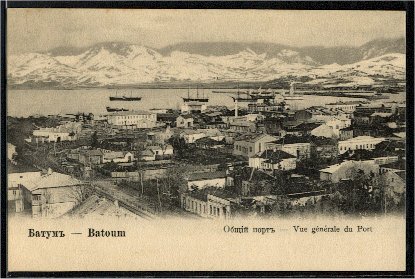
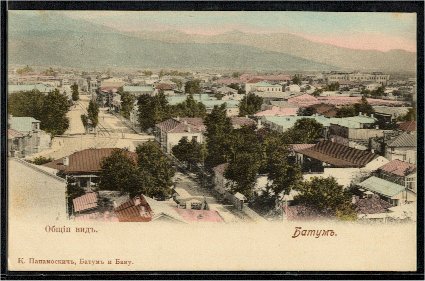
While searching the web for Batum stamps I
came across your page with illustrations of the Aloe
Tree stamps with British Occupation overprints.
Regretably all the illustrations are forgeries
9/29/09 - Back in Februray of this year, visitor Luis Martin responded to my request
for images of authentic Batum stamps with the note "Ray Ceresa is correct they are forgeries, one of the 3 or 4 different
forgeries of the aloe tree sets" and the three scans below.
Then a couple of weeks ago, Georg Wiesbauer sent the scan below, with the note
"Attached a scan of genuine ones, expertized and signed Dr. Ray Ceresa." (!)
This all led me to wonder "How does one distinguish the real ones from forgeries?"
I examined the various scans, and couldn't see any obvious differences.
"Alphabetilately: From A is for Advertising Cover thru Z is for Zeppelin Post"
click here to go to the site index.
Commentary text Copyright © 2009, William M Senkus
Send feedback to the webmaster: CLICK HERE
Created -- 03/12/2002
Updated -- 09/29/2009

